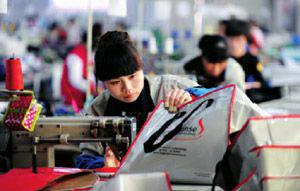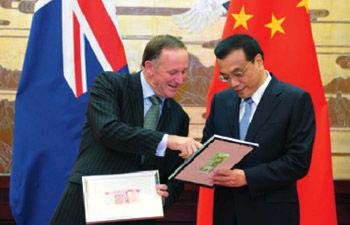Navy Drill
2014-04-11
Marines with the Chinese navy participate in a war game in north Chinas Inner Mongolia Autonomous Region.
The drill, which concluded on March 15, was aimed at honing the navys cross-regional mobility and abilities in extended combat in extremely cold or otherwise non-typical environments.
Power List
Chinas Central Government now has 1,235 administrative approval items in total, after last years extensive cull, according to a list published on March 17.
The list, available on the State Commission Office for Public Sector Reforms website (Scopsr.gov.cn), lists the items that come under 60 central government departments. For each item, the list spells out the responsible authority, approval object and its legal basis.
Publication of the list is a major step in the transformation of government functions, said a statement by the State Council office in charge of the system. No department is authorized to create new approval items and the market should be allowed to do anything not specifically prohibited by law, the statement said.
The public have been asked for feedback on further reform of approvals via the website, by phone or e-mail.
Terrorism Denounced
China on March 19 reiterated its stance on fighting against the East Turkistan Islamic Movement (ETIM), a terrorist group that voiced support for a deadly terrorist attack in a railway station in southwest China on March 1.
ETIM has released a video online and expressed support for the attack in Kunming, capital of Yunnan Province, which killed 29 and injured another 143.
“The video exposed the terrorist nature of the ETIM,” Foreign Ministry spokesman Hong Lei said at a daily news briefing. He said that fighting against the ETIM is a key component of the international fight against terrorism.
Hong called on the international community to fully recognize the terrorist nature of the “East Turkistan”forces, as represented by the ETIM, and the damage they have caused, and to support Chinas anti-terrorism stance.
The ETIM, listed by the UN Security Council as a terrorist group, claimed responsibility for the Tiananmen Square attack last October in Beijing in which five people were killed and 40 others injured.
Protecting Petitioners
Chinas new rules for better management of petitions have prohibited putting petitioners under any form of confinement.endprint
“Various political and legal organs should further regulate the handling of lawsuit-related petitions, resolutely avoiding blocking the people from normal petitioning by any means,” said a circular released on March 19 by the general offices of the Communist Party of China Central Committee and the State Council.
Petitioning, also known as “letters and calls,” is the administrative system for hearing public complaints and grievances.
Petitioners generally see injustice in land acquisition, social security, education, healthcare or environmental protection. They can take their grievances to a higher level if they fail to get satisfactory feedback from local petition offices, but officials often prevent them from raising such cases with their superiors.
The circular stresses that illegal or indirect confinement of petitioners is strictly prohibited, and that leading officials of related law enforcement organs are responsible for receiving petitioners and reading their letters.
Lottery Sales
Welfare lottery sales have exceeded 1 trillion yuan ($161 billion) since the draw was launched in China in 1987, the lottery watchdog revealed on March 18.
About 310 billion yuan ($50 billion) has been raised through the welfare lottery, helping fund over 300,000 charity projects and benefit hundreds of millions of people, according to the Ministry of Civil Affairs.
So far the welfare lottery industry employs more than 400,000 people and has created tax revenue of over 20 billion yuan ($3.22 billion), according to the ministry.
Water Risks
A report released by the environmental authority on March 14 estimated that a total of 280 million residents in China are using unsafe drinking water.
The report, issued by the Ministry of Environmental Protection, was based on a sampling survey of 91,527 permanent residents aged 18 and above in 31 provincial-level regions to evaluate Chinese peoples exposure to environmental risks. The survey was conducted between 2011 and 2012.
The survey also found that a total of 110 million Chinese people are living less than 1 km away from at least one industrial site with pollution concerns, such as petrochemical, coking or thermal power plants.
Moreover, about 140 million people live within 50 meters of a main communication artery, the report said.
Climate Report
A new collaborative report has provided practical recommendations for greater cooperation between China and India in addressing climate change.endprint
The China India Low Carbon Study, the first project of its kind, was launched on March 17 in Beijing.
The study examines the main factors in low carbon development—financing, low-carbon technologies and on-the-ground implementation.
The report builds a case for exchange between China and India. It notes that developing nations are more likely to focus on innovation that contributes to local environmental benefits and human development, and calls for more public sector funding for lowcarbon technologies.
Under the Copenhagen Accord signed in 2009, China and India have committed to reducing their carbon dioxide emissions per unit of GDP by 40 to 45 percent and 20 to 25 percent, respectively, from 2005 levels by 2020.
Curriculum Reform
A pilot project to improve placement courses in around 100 high schools nationwide began on March 18.
Dai Jiagan, Deputy Director of the Chinese Society of Education, said that the Chinese Advance Placement courses (CAP) will give more choice to gifted and talented children.
The courses cover calculus, linear algebra, probability and statistics, writing, English, physics, and economics.
Dai said that in China, a dozen elite high schools and universities have joined together to develop CAP courses, but still lack unified standards on courses, teachers training and evaluation of students.
The 100 high schools chosen will be announced later this year.
Fresh Air
Tourists take pictures at Gulangyu Island in Xiamen, southeast Chinas Fujian Province.
On March 19, Fujian began releasing the countrys first ever“fresh-air index” to promote eco-tourism.
Unlike indicators released by environmental departments that focus on urban air quality, the new index reflects air-quality changes at tourist attractions, said Chen Yihui, deputy chief of Fujians tourism bureau.
Tourists can track updates on the bureaus website and its accounts on social networking sites, according to Chen.
Tiger Center
The worlds largest breeding center for Siberian tigers, which is located in northeast Chinas Heilongjiang Province, is expected to see around 100 births this year, according to its management. In the past 10 years, the center has adopted planned breeding so as to promote good genes among its population.
Trading Band Widenedendprint
Chinas central bank widened the yuans daily trading band from the current 1 percent to 2 percent on March 17.
Chinese banks now can exchange the yuan in the foreign exchange spot market at 2 percent above or below the central parity against the U.S. dollar announced by the China Foreign Exchange Trading System each trading day, according to the statement from the Peoples Bank of China (PBC).
The move will enhance the floating flexibility of the yuan exchange rate and improve the efficiency of capital allocation, facilitate economic restructuring and beef up the decisive role of the market in allocating resources, the PBC said.
China has taken a gradual and steady pace in raising its currencys daily trading limit, from 0.3 percent in 1994 to 0.5 percent in 2007 and 1 percent in 2012 to the most recent 2 percent.
The Chinese yuan experienced continued weakening against the U.S. dollar in February, causing widespread concerns over its domestic and international impacts on trade and the financial sector. The widening of the trading band will not lead to steep depreciation of the Chinese yuan, the central bank said, citing the improving balance of payments and rich foreign exchange deposit.
The PBC will further push the liberalization of the yuans exchange rate and diversify foreign exchange products to build a market-guided and properly regulated floating exchange rate system.
Growth Moderated
Home prices in major Chinese cities grew at a slower pace in February, with fewer cities seeing month-on-month price rises, official data showed on March 18.
In February, new home prices in 70 major cities tracked by the National Bureau of Statistics (NBS) rose by an average of 11.1 percent year on year, slowing by 1.3 percentage points from January, the NBS said in a statement.
Prices for existing homes rose 6.4 percent year on year, compared with an average growth of 7.4 percent in January, according to the statement.
Month on month, 57 out of the statistical pool of 70 cities saw rises in new home prices, fewer than the 62 cities that experienced the same phenomenon in January. Prices dropped in four cities and stayed unchanged from a month ago in the other nine cities.
For existing homes, prices increased in 46 cities month on month, down from 48 cities in the previous month. Prices dropped in 15 cities and remained flat in nine cities, the NBS said.
“The deceleration in home price growth was partly due to tapering pentup demand after rapid home sales growth in 2013,” said Lu Ting, chief China economist with Bank of America Merrill Lynch.endprint
Moreover, tight mortgage conditions and higher second-home mortgage down payments in many major cities could also have weakened property demand, Lu said.
Cutting Red Tape
Chinas banking regulator said on March 19 that it will simplify administrative procedures for establishing rural commercial banks and credit cooperatives.
The China Banking Regulatory Commission (CBRC) said the procedures to be scrapped, totaling 13, include approvals over appointment of senior management, banks fund custodian services, and stock collateral loan business under new regulations.
The new rules aim to simplify the conditions for setting up rural commercial banks and credit cooperatives as well as making it easier for all kinds of capital to be included in building the rural financial system.
However, the regulator said the banks performance, including their strategic development and company management, will be supervised after they are established.
The total assets of small and medium-sized financial institutions in rural China stood at 19.45 trillion yuan($3.17 trillion) as of the end of January, accounting for 13.1 percent of the banking sectors total in the country.
Forex Surplus
Chinese banks bought more foreign currency than they sold in February, data from the State Administration of Foreign Exchange showed on March 19.
This is the seventh consecutive month in which banks have reported such a surplus. However, the surplus in February was 37.5 percent lower than that in January, according to the nations top foreign exchange (forex) regulator.
The banks approved for forex transactions in China purchased foreign currency worth 890.4 billion yuan($145.97 billion) in February while selling foreign currency worth 610.8 billion yuan ($98.1 billion), creating a surplus of 279.6 billion yuan ($44.9 billion). Forex transactions are a major cause of fluctuations in Chinas forex reserves. Surpluses may suggest pressure from trans-border capital inflow.
Tramcar Contracts
Chinese train manufacturer CNR Corp. has signed contracts with Ethiopia to provide 41 modern tramcars, marking the entry of Chinese tramcars into Africa, CNR said on March 17.
The tramcars will be customized for use in Ethiopias capital of Addis Ababa, where the altitude is 2,400 meters and ultraviolet light is strong.
According to CNR, the tramcars are the worlds most sunlight-resistant and will use special components in their glass, rubber, paint and cable materials. They can travel at a maximum of 70 km per hour.endprint
CNR will deliver its first batch of tramcars to Ethiopia at the end of 2014.
CNR, one of the largest train makers in China, manufactures a range of products, from locomotives to highspeed trains, which have been widely used for the countrys railway services.
Speeding Up
China will accelerate the construction of transport infrastructure to facilitate the countrys rapid urbanization, according to a national plan released on March 16.
The 2014-20 urbanization plan unveiled by the State Council said regular railways will cover cities with more than 200,000 residents by 2020, and highspeed railways will connect those with above 500,000 residents.
Expressways will link cities with over 200,000 residents, according to the plan.
China also aims to expand its civil aviation network, covering about 90 percent of the total population.
The plan said efforts will be made to strengthen connectivity among city clusters and to improve transport services for small cities and towns.
Optimistic Outlook
U.S. companies in China remained optimistic about the business environment but would be more cautious in making investments due to rising costs and narrowing profit margins, a survey showed on March 19.
The survey, conducted by the American Chamber of Commerce in China (AmCham China), showed over 80 percent of the 365 respondents perceive Chinas investment environment as improving or staying the same.
Some 75 percent are optimistic or slightly optimistic about their business outlook in China in the next two years, according to the survey.
But despite the short-term optimism, the companies are increasingly cautious about future investments as growth in revenue and profits slowed.
“The survey reflects the current realities of operating in China and the associated uncertainty, but also the optimism and confidence among AmCham China members that the countrys leadership is set on reform and that foreign business has an important role in Chinas future,” said AmCham China Chairman Gregory Gilligan.
Small Bags, Big Hit
Workers sew plastic woven bags in Kangping County of Shenyang, Liaoning Province.
Kangping has become northeast Chinas production base of plastic woven bags, with an annual output of 26.3 billion yuan ($4.2 billion) in 2013. It has also created over 20,000 jobs for local residents. Bags produced in Kangping have been exported to over 30 countries.
One Step Ahead
Chinese Premier Li Keqiang and visiting New Zealand Prime Minister John Key announced the beginning of direct trading between Chinas currency, the yuan, and the New Zealand dollar in Beijing on March 18.endprint
